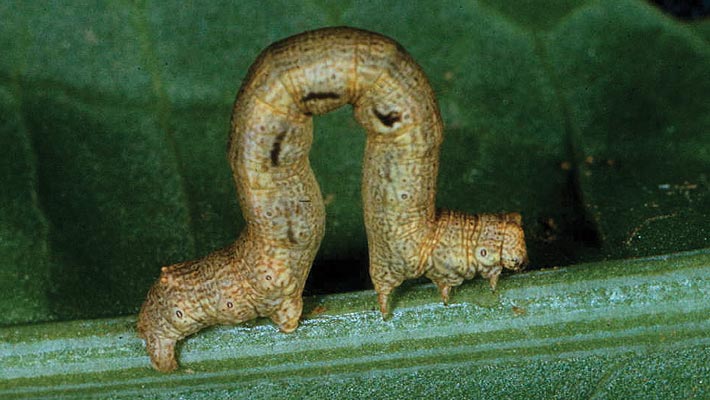Loopers are the larvae of geometrid moths and get their common name from their distinctive looping or ‘inching’ action.
Loopers (cont from last issue)
The loopers that attack pome fruit are the apple looper Phrissogonus laticostata, pome loopers Chloroclystis testulata and C. approximata, and the twig looper Ectropis excursaria.
Loopers feed on the leaves and, when feeding on fruit, generally graze the fruit surface making shallow damage which is distinguished from light brown apple moth (LBAM) damage because it occurs on exposed rather than protected surfaces of the fruit.
Occasionally loopers create crescent-shaped series of small, deeper, single holes when the caterpillar anchors itself with its hind prolegs while it bores a hole and then pivots sideways, like a mechanical excavator, to make other feeding holes while anchored to the same spot.
As fruit matures, the wounds caused by the loopers become corky and sometimes develop into small lumps but generally they remain shallow and concave.
Adult looper moths are rarely seen because they are well camouflaged when resting on bark. The larvae have a habit of remaining still if they sense the presence of a predator (or human).
Larvae have three pairs of true legs on the thorax and unlike budworms, have only two pairs of abdominal prolegs that are at the end of the body.
Budworm larvae, like most moth larvae, have prolegs on each abdominal segment. The looping action of the looper larvae is the result of having prolegs only towards the rear of the abdomen.
Management
Management of Helicoverpa and loopers involves a combination of weed management, biological control, entomopathogens, early season monitoring, and careful selection of pesticides to avoid disrupting predators and parasitoids that would otherwise manage to keep other pests below economic thresholds.
The apple looper has a range of hosts, including acacia. Budworms feed on a wide range of weeds such as deadly nightshade, Noogoora burr, thistles, capeweed, dock, fat hen and marshmallow. Management of those weeds prior to flowering of pome fruit will not only reduce incidence of budworms but will also help reduce populations of LBAM and harlequin bugs.
However, this does not mean leaving bare earth in the inter row! Biological control agents such as parasitoid wasps require access to flowering plants for energy sources like sugar, so it is important to maintain a balance of plants in the inter row without promoting the weeds mentioned above.
Biological control
Several biological control agents actively work to control Helicoverpa and loopers.
(cont next issue)
See this article in Tree Fruit Dec 2022
Reproduced with permission and thanks to APAL and Australian Fruit Grower
Acknowledgements: The PIPS3 Program’s Strengthening cultural and biological management of pests and diseases project (AP19002) has been funded by Hort Innovation, using the apple and pear research and development levy, contributions from the Australian Government and co-investment from Agriculture Victoria. Hort Innovation is the grower-owned, not-for-profit research and development corporation for Australian horticulture.




















